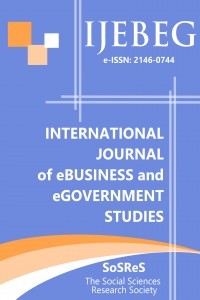DISCOURSE PATTERNS IN THE E-DISTANCE LEARNING FORUMS
DISCOURSE PATTERNS IN THE E-DISTANCE LEARNING FORUMS
Code-switching, Code mixing, Computer-mediated communication,
___
- Asmah Hj Omar (1982), Language and Society in Malaysia, Kuala Lumpur:
- Dewan Bahasa dan Pustaka. Carpenter, Don (2011), “Harissa.com: Narrative (s), Code-switching and Nostalgia-a Case Study”, (in : Laroussi, Foued –Ed., Code-switching, Languages in Contact and Electronic Writing ), Frankfurt: Peter Lang.
- Dorlejin, Margaret and Nortier, Jacomine (2009), “Code-switching and the Internet”, (in: Bullock, Barbara and Toribio, A. Jacqueline-Eds Linguistic code- switching), Cambridge: Cambridge University Press.
- Jacobson, Rodolfo. 2004. Language Mixing in Multilingual Malaysia. Newsletter http://www.crisaps.org/newsletter/backissue/Rodolfo%20Jacobson_summer2004. pdf [Accessed 20.8.2011] council of sciolinguistic (RC25).
- Jayatilal, Rekha (1998). Code-switching and Transfer in Email Correspondence
- Exchanged Between Four Malaysian Women. Jurnal pendidikan Tiga, Jilid 2; Bil http://www.scribd.com/doc/15339217/Codeswitching-in-ESL. [Accessed 8.2011]
- Kamisah Ariffin and Shameem Rafik-Galea (2008), “ Code-switching as
- Communication Device in Conversation”, (in: David, Maya., Mclellan, James., Rafik-Galea, Shameem and Abdullah, A.Nadzimah- Eds), Code-switching in Malaysia,Berlin:Peter http://www.crisaps.org/newsletter/summer2009/ariffin.doc [Accessed 20.8.2011]
- Marley, Dawn (2011), “Code-switching in website for the Moroccon Diaspora”;
- (in : Laroussi, Foued –Ed., Code-switching, Languages in Contact and Electronic Writing ), Frankfurt: Peter Lang. Muysken, Peter (2000), Bilingual Speech: a typology of code-mixing, Cambridge:
- Cambridge University Press. Myers-Scotton, Carol (1993), Social motivations for codeswitching, Oxford:
- Oxford University Press. Nor Azni Abdullah. 2003. Relational communication in organizational e-mail: a
- Malaysian case study. PhD thesis. University Malaya. Norizah Hassan and Azirah Hashim (2009), “Electronic English in Malaysia:
- Features and language in use”, English Today 100, Vol 25, No 4. Paolilo, John (1996) , “Language Choice on soc.culture.Punjab”, Electric Journal of Communication/REC 6 (3). http://ella.slis.indiana.edu/~paolillo/research/paolillo.publish.txt,
- Tsiplakou, Stavroula (2009), Doing Bi(Lingualism):Language Alternation as
- Performative Construction of Online Identities. Pragmatics 9 (3):361-391. Warschauer, Mark., Said, Ghada.R El and Zohry, Ayman (2007), “Language choice online: Globalization and identity in Egypt”, ( in Danet, Brenda and Herring, Susan-Eds., The Multilingual Internet.), Oxford: Oxford University Pressp.
- Zaemah A.Kadir, Marlyna Maros and Bahiyah A.Hamid (2012), “Linguistic
- Features in the Online Discussion Forums’, Journal of Social Science and Humanity, Vol 2, No 3, pp276-281.
- Başlangıç: 2009
- Yayıncı: Sosyal Bilimler Araştırmaları Derneği
EXPLORING A NEW ELECTRONIC RETAILING TREND IN TURKEY AND THE WORLD: PRIVATE SHOPPING
Nazlim TUZEL URALTAS, Didem KOROGLU
Lynda Priscilla Vincent Richard
ORGANIZATIONAL ADOPTION OF INFORMATION TECHNOLOGIES: A LITERATURE REVIEW
Ibrahim Arpaci, Yasemin Cetin Yardimci, Sevgi Ozkan, Ozgur Turetken
MODERN ECONOMY, ELECTRONIC FINANCIAL MARKETS AND ECONOMIC GROWTH IN SELECTED COUNTRIES
Monireh Dizaji, Naghmeh Sharifi, Fahimeh Esmaeli, Mina Mahjoub Laleh
HOW MARKETING AND CUSTOMERS WILL BE AFFECTED BY CLOUD COMPUTING?
Daniel K.N. Johnson, Kristina M. Lybecker, Jeffrey Moore
THE IMPACT OF INFORMATION AND COMMUNICATION TECHNOLOGY ON ECONOMIC GROWTH: TURKISH CASE
Yasuyuki Nishigaki, Yuzo Higashi, Wong Meng Seng, Hideki Nishimoto
Peyman Ghafari Ashtiani, Fateme Asadi
CYBERLOAFING PHENOMENON IN ORGANIZATIONS: DETERMINANTS AND IMPACTS
